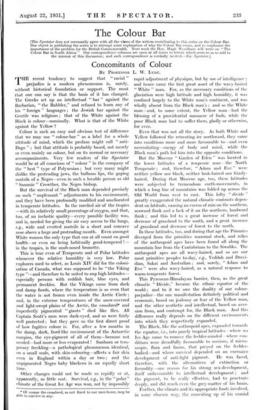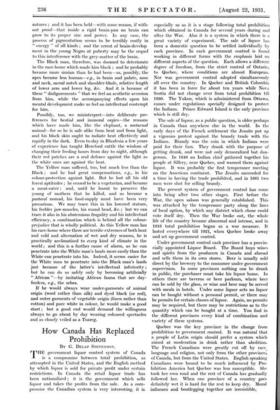The Colour Bar
(The Spectator does not necessarily agree with all the views of the writers contributing to this series on the Colour Bar. Our object in publishing the series is to attempt some explanation of why the Colour Bar exists, and to emphasize the importance of the problem for the British Commonwealth. Next week the Hon. Hugh Wyndham will write on " The Colour Bar in South Africa." Our correspondence columns are open at all times to letters which seem to us to add to the interest of this 'discussion; and such correspondence is cordially invited.—En. Spectator.]
Concomitants of Colour
By PROFESSOR L. W. LYDE.
THE recent tendency to suggest that " racial " prejudice is a modern phenomenon is, surely, without historical foundation or support. The most that one can say is that the basis of it has changed. The Greeks set up an intellectual " bar " against the Barbarian, " the Babbler," and refused to learn any of his " foreign " languages ; the Jewish bar against the Gentile was religious ; that of the White against the Black is colour—nominally. What is that of the White against the Yellow ?
Colour is such an easy and obvious test of difference that we may use " colour-bar " as a label for a whole attitude of mind, which the profane might call " anti- Dago " ; but that attitude is probably based, not merely or even mainly on colour, but on its normal or necessary accompaniments. Very few readers of the Spectator would be at all conscious of " colour " in the company of the " best " type of Polynesian ; but very many might dislike the protruding jaws, the bulbous lips, the gaping nostrils of a Negro—even in such a lovable person as old " Sammie " Crowther, the Negro bishop.
But the survival of the Black man depended precisely on such " unpleasant " adjustments to his environment, and they have been profoundly modified and ameliorated in temperate latitudes. In the rarefied air of the tropics —with its relatively small percentage of oxygen, and that, too, of an inelastic quality—every possible facility was, and is, needed for giving the air easy access to the lungs, e.g., wide and everted nostrils in a short and concave nose above a huge and protruding mouth. Even amongst White women the only type that can at all count on good health—or even on being habitually good-tempered !- in the tropics, is the snub-nosed brunette.
This is true even of Temperate and of Polar latitudes whenever the relative humidity is very low. Polar explorers used to select, as Louis XIV did for the coloni- sation of Canada, what was supposed to be "the Viking type "=- -and therefore to be suited to any high latitudes— especially persons with reddish hair, blue eyes, and permanent freckles. But the Vikings came from dark and damp fiords, where the temperature is so even that the water is not frozen even inside the Arctic Circle ; and, in the extreme temperatures of the snow-covered and light-swept plains of the Arctic, the crossbred* and imperfectly pigmented " giants " died like flies. All Captain Scott's men were dark-eyed, and so were fairly well protected ; but they gave us the first direct proof of how fugitive colour is. For, after a few months in the damp, dark, fiord-like environment of the Antarctic margins, the eye-pigment of all of them—because not needed—had more or less evaporated ! Sunburn or tem- porary freckling—a pathological phenomenon identical, on a small scale, with skin-colouring—affects a fair skin even in England within a day or two ; and the unpigmented Negro baby blackens in an equally short time.
Other changes could not be made so rapidly or at, apparently, so little cost. Survival, e.g., in the " polar " climate of the Great Ice Age was won, not by impossibly * Of course the crossbred, as not fixed to one race-home, may bo able to survive in any. rapid adjustment of physique, but by use of intelligence ; and hence came the first great asset of the wavy-haired " White " man. For, as the necessary conditions of the glaciation were high latitude and high humidity, it was confined largely to the White man's continent, and was wholly absent from the Black man's ; and so the White man—and, to some extent, the Yellow man—had the blessing of a providential massacre of fools, while the poor Black man had to suffer them, gladly or otherwise, for ever.
Even that was not all the story. As both White and Yellow followed the retreating ice northward, they came into conditions more and more favourable to—and even necessitating—energy of body and mind, while the Black man's path led him into the opposite conditions.
But the Miocene " Garden of Eden " was located in the lower latitudes of a temperate zone—the North Temperate ; and, therefore, " Adam and Eve " were neither yellow nor black, neither lank-haired nor frizzly- haired. During that Miocene age, too, these latitudes were subjected to tremendous earth-movements, in which a long line of mountains was folded up across the Old World from west to east. This lofty " divide " greatly exaggerated the natural climatic contrasts depen- dent on latitude, causing an excess of rain on the southern, seaward flank and a lack of it on the northern, landward flank ; and this led to a great increase of forest and decrease of grassland to the south, and a great increase of grassland and decrease of forest to the north.
In these latitudes, too, and during that age the Primates diverged from the primitive mammal stock, and relics of the anthropoid apes have been found all along the mountain line from the Cantabrians to the Siwaliks. The anthropoid apes are all wavy-haired, and so arc our most primitive peoples to-day, e.g., Veddah and Dravi- dian, Sakai and Australian ; and, surely, " Adam and Eve " were also wavy-haired, as a natural response to warm-temperate forest.
This Pyrenean-Himalayan barrier, then, as the great climatic " Divide," became the ethnic equator of the world ; and to it we owe the duality of our colour- prejudice—the one manifestation definitely political and economic, based on jealousy or fear of the Yellow man, and the other aesthetic and intellectual, based on aver- sion from, and contempt for, the Black man. And this difference really depends on the different environments into which they respectively expanded. The Black, like the anthropoid apes, expanded towards the equator, i.e., into purely tropical latitudes—where no Ice Age came to remove the feebler-minded—where con- ditions were dreadfully favourable to noxious, if micro- scopic, flora and fauna, that preyed on the feebler- bodied—and where survival depended on an excessive development of anti-light pigment. He was faced, therefore, with the alternatives of extinction or fecundity—one reason for his strong sex-development, itself unfavourable to intellectual development ; and the pigment, to be really effective, had to penetrate deeply, and did reach even the grey-matter of his brain.
Further, the climate and its appropriate foods involved, in some " obscure way, the cementing up of his cranial sutures ; and it has been held—with some reason, if with- out proof—that inside a rigid brain-pan no brain can grow to its proper size and power. In any case, the process of pigmentation seems to be terribly costly in " energy " of all kinds ; and the arrest of brain-develop ment in the young Negro at puberty may be the sequel to this interference with the grey-matter of the brain.
The Black man, therefore, was doomed to deteriorate in the race-home which made him black ; and he probably became more simian than he had been—as, possibly, the apes became less human—e.g., in brain and palate, nose and neck, sacral notch and shoulder-blade, relative length of lower arm and lower leg, &c. And it is because of these " disfigurements " that we feel an aesthetic aversion from him, while the accompanying effects upon his mental development make us feel an intellectual contempt for him.
Possibly, too, we misinterpret—into deliberate pre- ferences for bestial and immoral orgies—the reasons which have made him, like the elephant, a nocturnal animal—for so he is safe alike from heat and from light, and his black skin ought to radiate heat effectively and rapidly in the dark. Even to-day in Rhodesia a few years of experience has taught Hereford cattle the wisdom of changing their feeding hours from day to night, although their red patches are a real defence against the light as the white ones are against the heat.
The Yellow man suffered, too, but much less than the Black ; and he had great compensations, e.g., in his colour-protection against light. But he lost all his old forest aptitudes ; he ceased to be a vegetarian, and became a meat-eater ; and, until he learnt to preserve the young of mothers that he killed, and so became a pastoral nomad, his food-supply must have been very precarious. We may trace this in his lowered stature, his feebler jaw-muscles, his round head, &c. ; but we can trace it also in his abstemious frugality and his intellectual efficiency, a combination which is behind all the colour- prejudice that is wholly political. As this Yellow man has his race-home where there are terrific extremes of both heat and cold and alternation of wet and dry seasons, he is practically acclimatised to every kind of climate in the world ; and this is a further cause of alarm, as he can penetrate into the White man's lands more easily than the White can penetrate into his. Indeed, it seems easier for the White man to penetrate into the Black man's lands just because of the latter's intellectual inferiority ; but he can do so safely only by becoming artificially " African "—by imitating African fauna that are day- feeders, e.g., the zebra.
If he would always wear under-garments of animal origin (wool rather than silk) and dyed black (or red), and outer garments of vegetable origin (linen rather than cotton) and pure white in colour, he would make a good start ; but a good end would demand the willingness always to go about by day wearing coloured spectacles and as closely veiled as a Tuareg.































 Previous page
Previous page